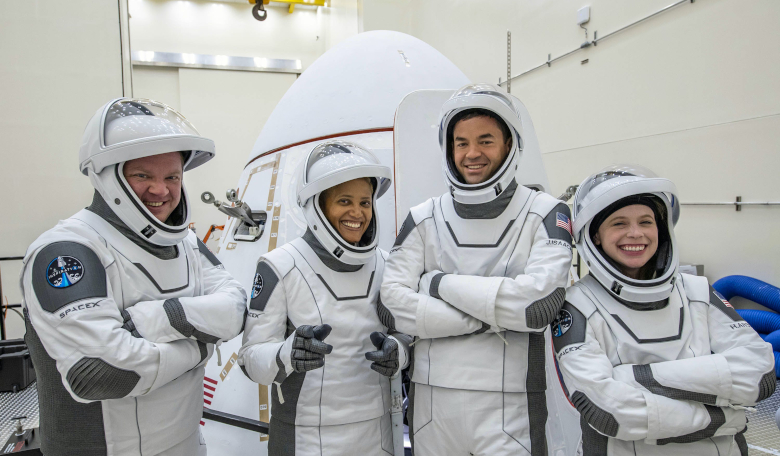For the first time in 60 years of human spaceflight, a rocket is set to launch four people into space on a three-day mission crewed solely by private citizens.
Known as the "Inspiration4" mission, this private flight will take place aboard a SpaceX Crew Dragon spacecraft atop a Falcon 9 rocket that is scheduled to lift off sometime during a five-hour launch window that opens from 8:02 pm EDT Wednesday 15 September (00:02 GMT Thursday).
If needed for any reason, a backup window is available opening at 8:05 pm EDT on Thursday, 16 September, however the latest forecast from the US Space Force’s 45th Weather Squadron predicts a 70 percent chance of favorable conditions for liftoff at the Cape Canaveral launch complex.
Inspiration4 will be led by American billionaire and accomplished pilot Jared Isaacman, a 38-year-old entrepreneur who's bankrolling the entire trip.
“In fulfilling a personal and lifelong dream, I recognise the tremendous responsibility that comes with commanding this mission. While a historic journey awaits us in space, I hope this mission reinforces how far inspiration can take us and the extraordinary achievements it leads to here on Earth,” Isaacman says.
The exact price he paid SpaceX hasn't been disclosed, but it is likely to run into the tens of millions of dollars.
Isaacman is taking two sweepstakes winners with him, Chris Sembroski and Dr. Sian Proctor, along with Hayley Arceneaux, a physician assistant who survived childhood cancer.
Now working at St. Jude – the very place that saved her life – Arceneaux was 10 when diagnosed with osteosarcoma, a type of bone cancer. Along with chemotherapy, she had much of her left thigh bone replaced with a titanium rod to combat the illness.
Arceneaux will be the first person in space with a prosthesis and at age 29, will also be the youngest American in space, beating the late Sally Ride, who became the first American woman in space in 1983 at age 32.
Chris Sembroski, 42, is a former US Air Force employee who now works in the aviation industry. As a college student, Sembroski volunteered with ProSpace, a grassroots lobbying effort that promoted legislation in Washington to help open space travel and allow companies like SpaceX to exist.
Sian Proctor, a 51-year-old geology professor with a pilots license, was almost selected to become an astronaut for NASA in 2009.
Proctor has completed four analog missions, including the all-female Sensoria Mars 2020 mission at the Hawai’i Space Exploration Analog and Simulation (HI-SEAS) Habitat as well as the NASA-funded four-month Mars mission at HI-SEAS. She will be only the fourth African American woman to go to space.
The four crew will represent the four values promoted by the mission: leadership; hope; generosity; and prosperity, whilst also showing that space is accessible to people who have not been handpicked and trained for many years as astronauts.
That is not to say that they have not prepared for the journey ahead.
For the past six months, the crew have endured intense, rapid spins in fighter jets and centrifuges, experienced weightlessness for a few seconds on parabolic flights and put their lungs to the test with a high altitude, snowy trek on Mount Rainier in the northwestern United States.
"I know that my prosthesis can now handle 8 G's of force," Arceneaux said.
Time was also spent at the SpaceX base, though the flight itself will be fully autonomous.
Tests will be carried out before and after the flight to study the effect of the trip on the bodies of non-astronauts, and over the three days in orbit, their sleep, heart rate, blood and cognitive abilities will be analysed.
Weather permitting, after take off, the SpaceX Crew Dragon’s trajectory will take it to an altitude of 575 kilometers (357 miles), deeper into space than the International Space Station (ISS).
This is significantly further than the spaceflights offered by Virgin Galactic and Blue Origin, which settle for the Kármán line; an imaginary border 100 kilometres (62 miles) above Earth's mean sea level that straddles the hazy division between Earth's atmosphere and outer space.
The 8.1 by 4 metre Dragon spacecraft that is capable of carrying up to 7 passengers to and from Earth orbit, and beyond will be packed with crew essentials as well as scientific equipment dedicated to micro-gravity research and experimentation.
“Inspiration4 is committed to assigning the maximum possible mass towards this valuable research, providing access to space for inspiring projects that are otherwise unable to overcome the high barriers of traditional space-based research,” the mission’s website says.
Crew Dragon will splash down off the coast of Florida at the end of the mission.











